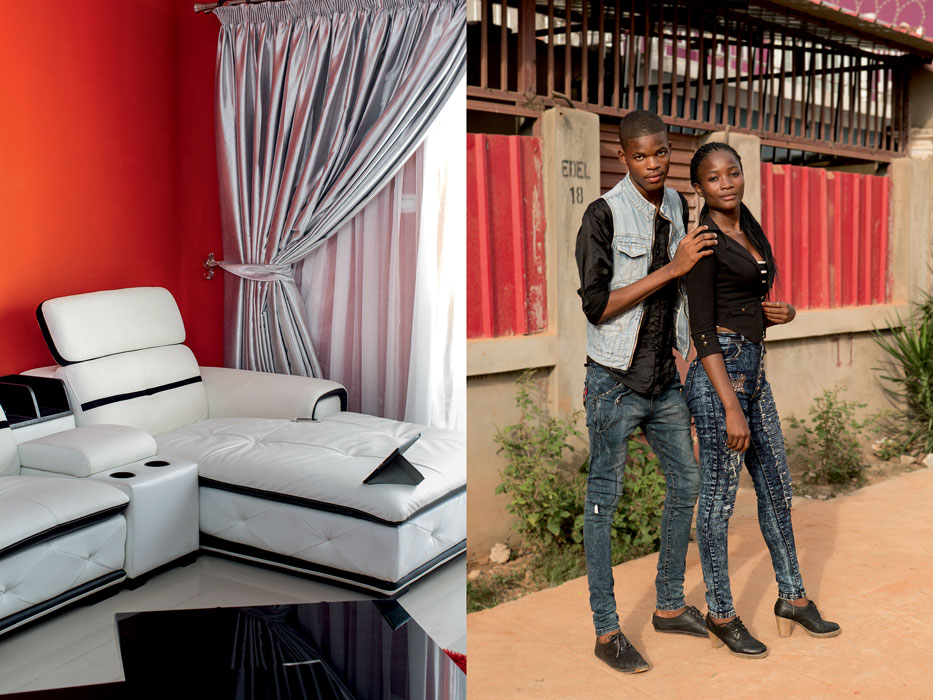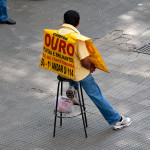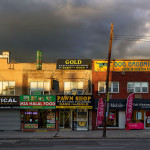Exhibition
in Zürich / Switzerland
- Flurina Rothenberger: aus dem Buch “I love to dress like I am coming from somewhere and I have a place to go”, images from the African Continent, 2004 – 2014, Edition Patrick Frey, Zürich, 2015
- Annelies Štrba: aus: “Noonday”, 2005 – 2014, Pigmentdruck, 20 x 30 cm
- Gilles Fontolliet: aus: “Sowayma”, 2013 – 2015, Laser-Print, 35.8 x 23.6 cm
- Shan Feiming: Love (Detail), 2011, Pigmentdruck auf Kunstdruck-Barytpapier, 122 x 504 cm
- Lina Scheynius: aus “diary”, 2014, Fibre-based hand print, 15 x 10 cm, Bild: © Lina Scheynius / Courtesy Christophe Guye Galerie
- Lukas Hoffmann: Weide bei Bochum, 2014, Gelatin Silver Print, 54.5 x 40 cm
- Marike Schuurman: Gold 2, 2009, Pigment Ink Print, 60 x 90 cm
- Paul Graham: Pawn Shop, Ozone Park, New York, 2013, Pigment Ink Print, 161 x 244 cm, Bild: © Paul Graham, Courtesy carlier | gebauer
We see the world in images. Our view of the world is shaped by them. Over the course of the past ten years, the exhibition series “World Images”, showcasing contemporary international photography, has been providing opportunities to look at things and people differently and, in doing so, perhaps, to see oneself differently as well. The focus of “World Images 6” is on the individual: on how we find direction, how we are manipulated, how we are left to our own devices, how we move within the community, how we perceive society and the self.
The “World Images” exhibitions at Helmhaus, which are always held in winter, have become something of a tradition. For the sixth time in ten years, the latest in the series offers insights into how various artists see and image the world around them. With each exhibition, the number of visitors has increased. In such uncertain times as these, we feel a mounting need to understand more about the world than we can glean from the mass media. Artists portray the world differently. Their gaze penetrates the very essence of things, dares to be subjective and even to question the existential.
Geographically, this exhibition, the sixth in the series, spans five continents and subcontinents, with the exception of Australia, visits fifteen African countries and goes to places as diverse as Jordan, Russia, China, Brazil, the USA, Canada as well as Sweden, Belgium, Germany, Italy, before returning to Switzerland. Thematically, it focuses on people, how they see themselves, how they interact with one another, and how they behave in the wider social environment.
The intensity of experiencing a single, exemplary image counters the visual overload that is so often noted. Photography is an ideal medium through which to explore the relationship between people and the world around them. Its delimitation of space and time invites focused contemplation. The reality it portrays is one that has been transformed and imaged. In documenting reality, it documents a subjective notion of reality. The camera, as an “extension of the eye”, delves into that which arouses the interest of the photographer. And the view it presents triggers reflection. What appears at first to be unfamiliar ultimately leads us back to ourselves.
This existential dimension is an intrinsic aspect of the works in the exhibition: they are images that confront us with ourselves. For instance, by making us aware that we can feel as lost in suburban no-man’s-land as we can in the jungle; but also by making us realise that we can face this feeling with open eyes and relate to what it is that creates such a sense of insecurity and manipulation. The exhibition also reveals relationships between ourselves and nature, ourselves and culture, that are less fraught; relaxed interpersonal relationships when there is openness, trust, and when there is mutual exchange instead of aloof reserve – be it within the (extended) family, the social fabric of a village community or a city. In principle, all of the images demonstrate that this attitude to others also requires a corresponding attitude to the self – for each photograph reflects not only its subject matter, but also the view of the artist. This is particularly evident when a photographer points the camera at herself.
“World Images 6” is also exciting in its breadth of form: Sharply focused, large-format prints are included alongside atmospheric images in which such clarity of technical detail is not a priority. Whether pasted onto a carrier, heavily framed or simply pinned to the wall, many different presentational aspects of contemporary photography can be found here.
The six “World Images” exhibitions since 2005 have presented 49 diverse and at times even contradictory insights into an inexhaustible subject of visual enquiry. As ever, this time around we present four photographers from Switzerland and four from other countries. Four of them are women, and four are men. The entire long-term project by curatorial duo Andreas Fiedler and Simon Maurer has been documented successively in six illustrated and commentated volumes published by Verlag für moderne Kunst, now comprising more than a thousand pages in all and providing what may be described as a veritable compendium of contemporary photography.
The exhibition “World Images” 6 begins with young Swedish photographer Lina Scheynius turning the camera on herself. She is her own world. Here, photography is both a quest for identity and a proof of existence. The innermost and outermost of her own body is shared with the world. The exhibition then leaps to Africa: what image do we have of everyday life in Africa? Young Swiss photographer Flurina Rothenberger, who grew up in Africa, brings us a book brimful of images showing the talent of a continent in dealing with contrasts. The present becomes the theme in the dual images by Paul Graham: is there even such a thing as the present? This British photographer juxtaposes two images of New York street life, between which there is a gap: representing the ephemeral? The present and happiness are both impossible to grasp: In the next room, as though from some previous decade and yet as though entirely in the present, we find the works by Annelies Štrba featuring her extended family. For the first time, the “grand and still young lady” of Swiss photography presents her works on paper. Memory, remembrance and a different kind of community are the themes addressed by the young Swiss artist Gilles Fontolliet. In Sowayma, a Jordanian village on the Dead Sea, he has created portraits of many people and has given them the pictures. Lukas Hoffmann, a Swiss photographer based in Berlin, strolls through suburbs and brownland spaces, where he finds unusual subjects for his images: bushes and fences, broken barriers and shadowy forms become both concrete and abstract visual elements. Dutch photographer Marike Schuurman, who also lives in Berlin, has devoted her attention to the advertising-free public spaces of São Paulo. Banished from the walls of buildings, advertisements are now carried on the backs of human sandwich boards proclaiming the potential to turn gold into cash. The monumental works of young Chinese photographer Shan Feiming address the sense of solitude in nature and among people, of love and the loss of love, hurt and care – an existential statement that is both personal and social.
The exhibition is accompanied by the sixth volume in the series “World Images”. The book contains high-quality illustrations of almost all the works shown in the exhibition, along with informative and authoritative texts by Andreas Fiedler, artistic director of KINDL – Centre for Contemporary Art in Berlin, and Simon Maurer, director of Helmhaus Zürich. The book is designed by sofie’s Kommunikationsdesign, Zurich, and is distributed by Verlag für moderne Kunst.
Six years ago, starting with “World Images 3”, Helmhaus Zürich began to accompany each of these exhibitions with concerts. Since then, we have organised more than fifty concerts – each one of them unique and performed within an environment that can never be repeated – combining music and art. The concerts have featured stars such as Stephan Eicher and Pierre Favre as well as rising talents such as Vera Kappeler and Simone Keller. The musical programme is in the hands of Juliana Müller, who has selected two musicians for solo performances to accompany “World Images 6”. Both of them live in Switzerland and both have brought the sounds of their respective backgrounds to Zurich. Fatima Dunn, cellist and singer-songwriter with Irish roots, weaves cello, voice and loop-station into the lyrical creations of a one-woman orchestra. Elina Duni interprets Albanian folk songs with the stylistic vibe of modern jazz, accompanied by a touch of guitar, percussion and piano. The concert programme, too, ensures a meeting of cultures.
Shan Feiming (*1978 in Lin’an, China; lives in Hangzhou, China)
Gilles Fontolliet (*1981 in Zurich; lives in Zurich)
Paul Graham (*1956 in Stafford, England; lives in New York)
Lukas Hoffmann (*1981 in Zug; lives in Berlin)
Flurina Rothenberger (*1977 in Männedorf; lives in Zurich)
Lina Scheynius (*1981 in Vänersborg, Sweden; lives in London)
Marike Schuurman (*1964 in Groningen, Netherlands; lives in Berlin)
Annelies Štrba (*1947 in Zug; lives in Richterswil and Ascona)
Opening hours Tues-Sun 10 am – 6 pm, Thur 10 am – 8 pm
Welt – Bilder 6
Wir sehen die Welt in Bildern. Und entwickeln daraus unser Weltbild. “Welt – Bilder”, eine Ausstellungsreihe über aktuelle, internationale Fotografie, bietet seit zehn Jahren Möglichkeiten, sich anderen und anderem, aber auch sich selbst anzunähern. “Welt – Bilder 6” zielt auf den Menschen ab: wie er sich orientiert und Halt sucht, wie er manipuliert und auf sich selber zurückgeworfen wird, wie er Gemeinschaft und sich selbst erlebt.
Die “Welt – Bilder” Ausstellungen im Helmhaus, jeweils im Winter, sind zu einer Tradition geworden: Zum sechsten Mal innert zehn Jahren eröffnen sich Einblicke in Bilder aus dieser Welt. Und zeigen, wie Künstlerinnen und Künstler die Welt sehen. Mit jeder Ausstellung nahm die Besucherzahl zu: In unsicheren Zeiten wie diesen steigt das Bedürfnis, mehr über die Welt zu erfahren, als in den Massenmedien steht. Künstler zeigen die Welt anders: Ihr Blick geht den Dingen auf den Grund, wagt Subjektivität und befragt auch die eigene Existenz.
Geografisch bereist die sechste Ausgabe alle fünf Kontinente und Halbkontinente mit Ausnahme von Australien, begibt sich in fünfzehn Länder Afrikas, nach Jordanien, Russland, China, Brasilien, in die USA, nach Kanada und schliesslich nach Schweden, Belgien, Deutschland, Italien und zurück in die Schweiz. Thematisch zielt sie auf den Menschen ab: wie er sich selbst sieht, wie er sich in der Begegnung mit seinen Nächsten zeigt und wie er sich im gesellschaftlichen Umfeld bewegt.
Die intensive Begegnung mit dem einzelnen, exemplarischen Bild widersetzt sich der vielfach konstatierten Bilderflut. Fotografie ist ein ideales Medium, um sich mit dem Verhältnis zwischen dem Menschen und dem, was ihn umgibt zu beschäftigen. Indem sie Raum und Zeit begrenzt, fördert sie die konzentrierte Auseinandersetzung. Es ist eine transformierte, zum Bild gemachte Realität, die sich hier zeigt. Sie dokumentiert – aber sie dokumentiert eine Vorstellung von der Realität, die subjektiv ist. Die Kamera als “verlängertes Auge” vertieft sich in das, was das Interesse der Fotografierenden weckt. Und bietet es den Betrachterinnen und Betrachtern an, um Reflexionen in Gang zu bringen. Was uns zunächst fremd erscheint, führt uns letztlich auf uns selbst zurück.
Diese existenzielle Dimension ist den ausgestellten Arbeiten eigen: Es sind Bilder, die uns mit uns selbst konfrontieren. So machen sie zum Beispiel bewusst, dass in der Grossstadt genauso wie im suburbanen No Manʼs Land und wie im Urwald ein Gefühl von Verlorenheit droht. Dass es aber auch darum geht, diesem Gefühl mit offenen Augen zu begegnen: sich in ein Verhältnis zu setzen mit dem, was verunsichert und manipuliert. Die Ausstellung eröffnet auch weniger angespannte Beziehungen zwischen Mensch und Natur und zwischen Mensch und Kultur. Entspannte Beziehungen zwischen Menschen: dann, wenn Offenheit da ist, wenn Vertrauen entgegengebracht wird, wenn Austausch statt Reserviertheit gepflegt wird – sei das innerhalb der (Gross-)Familie, sei es im sozialen Gefüge eines Dorfes oder einer Stadt. Dass dieser Umgang mit anderen auch einen entsprechenden Umgang mit sich selbst voraussetzt, zeigen im Prinzip alle Bilder – denn jede Fotografie reflektiert nicht nur ihr Motiv, sondern auch die Sicht des Künstlers. Besonders augenfällig wird das, wenn eine Fotografin ihre Kamera auf sich selbst richtet.
Die Ausstellung “Welt – Bilder 6” ist schliesslich auch formal ein Erlebnis: Das grösste Bild ist fast hundert Quadratmeter gross, das kleinste ist ein Abzug im Albumformat 10 x 15 cm. Messerscharfe, grossformatige Prints sind genauso präsent wie atmosphärische Bilder, für die Schärfe kein Kriterium ist. Tapeziert, in schweren Kastenrahmen, ungeschützt an die Wand gepinnt: Viele Präsentationsformen aktueller Fotografie sind im Helmhaus zu sehen.
Die sechs “Welt – Bilder” Ausstellungen präsentieren seit 2005 nun 49 differenzierte, manchmal auch widersprüchliche Einsichten in einen unerschöpflichen Gegenstand. Wie immer stammen auch diesmal vier Fotografierende aus der Schweiz und vier aus dem Ausland, sind vier Frauen und vier Männer beteiligt. Das langfristige Projekt der beiden Kuratoren Andreas Fiedler und Simon Maurer ist in sechs kommentierten Bildbänden festgehalten, die im Verlag für moderne Kunst erscheinen und mittlerweile auf über tausend Seiten so etwas wie ein Kompendium der zeitgenössischen Fotografie darstellen.
Gleich zu Beginn der Ausstellung “Welt – Bilder 6” richtet die junge Schwedin Lina Scheynius die Kamera auf sich selbst: Die Fotografin ist sich ihre eigene Welt, Fotografie ist hier Identitätssuche und Existenzbeweis in einem. Und das Innerste, das Äussere des eigenen Körpers, wird mit der Welt geteilt. Die Ausstellung springt dann nach Afrika: Haben wir ein Bild vom Alltag in Afrika? Die junge Schweizerin Flurina Rothenberger, selber in Afrika aufgewachsen, versorgt uns mit einem Buch voller Bilder, die das Talent dieses Kontinents zeigen, mit Kontrasten umzugehen. Gegenwart ist das Thema der Bildpaare von Paul Graham: Gibt es Gegenwart überhaupt? Der Brite setzt jeweils zwei Bilder aus dem New Yorker Stadtraum nebeneinander. Dazwischen klafft ein Spalt: für die Vergänglichkeit? Gegenwart, Glück, die sich beide nicht fassen lassen: Wie aus dem vorletzten Jahrhundert und doch sehr gegenwärtig erscheint im nächsten Saal die Arbeit von Annelies Štrba über ihre Grossfamilie. Zum ersten Mal überhaupt zeigt die “grand and still young lady” der Schweizer Fotografie Arbeiten auf Papier. Um Erinnerungskultur und eine andere Art der Gemeinschaft geht es beim jungen Schweizer Künstler Gilles Fontolliet. In Sowayma, einem jordanischen Dorf am Toten Meer, hat er zahlreiche Menschen porträtiert und ihnen die entstandenen Bilder geschenkt. Lukas Hoffmann, Schweizer mit Wohnsitz in Berlin, streift durch Vorstädte und Brachen und trifft dort auf abseitige Motive, die er zu Bildern macht. Sträucher und Zäune, demolierte Absperrungen und Schattenwürfe werden zu ebenso konkreten wie abstrakten Bildelementen. Die Holländerin Marike Schuurman, auch sie Wahlberlinerin, widmet ihre Arbeit dem werbebefreiten öffentlichen Raum von São Paulo. Von den Hauswänden verbannt, landet Reklame schliesslich auf dem Rücken von menschlichen Plakatsäulen, die dafür werben, Gold zu Geld zu machen. Die monumentalen Werke des jungen Chinesen Shan Feiming schliesslich handeln von der Verlorenheit in der Natur und zwischen Menschen, von Liebe und Liebesverlust, von Verletzungen und deren Pflege: ein existenzielles, ebenso persönliches wie gesellschaftliches Statement.
Zur Ausstellung erscheint der sechste Band der Reihe “Welt – Bilder / World Images”. Dem Thema entsprechend sind im Buch fast alle ausgestellten Werke in hoher Qualität abgebildet, und Texte von Andreas Fiedler, künstlerischer Direktor des KINDL – Zentrum für zeitgenössische Kunst in Berlin, und Simon Maurer, Leiter des Helmhaus Zürich, bieten Hintergrundinformationen. Gestaltet ist das Buch von sofie’s Kommunikationsdesign, Zürich, den Vertrieb übernimmt der Verlag für moderne Kunst.
Mit der Ausstellung “Welt – Bilder 3” hat das Helmhaus Zürich vor sechs Jahren damit begonnen, in jeder Ausstellung zwei Konzerte zu organisieren. Inzwischen haben über fünfzig Konzerte stattgefunden, allesamt einmalig, weil in einer unwiederholbaren Umgebung stattfindend, die Musik und Kunst miteinander in Beziehung setzt. Stars wie Stephan Eicher und Pierre Favre sind im Helmhaus aufgetreten, aber auch junge Versprechungen wie Vera Kappeler oder Simone Keller. Das Musikprogramm liegt in den Händen von Juliana Müller, die für “Welt – Bilder 6” zwei Musikerinnen ausgewählt hat, die in Solokonzerten auftreten. Beide leben in der Schweiz und bringen Töne von ihren Ursprungsländern nach Zürich. Fatima Dunn, Cellistin und Singer-Songwriterin mit irischen Wurzeln, verwebt als “Ein-Frau-Orchester” Cello, Stimme und Loopstation zu poetischen Songs. Und Elina Duni interpretiert albanische Volkslieder mit Stilmitteln des modernen Jazz, begleitet von einem Hauch Gitarre, Schlaginstrumenten und Klaviertönen. Für eine Begegnung der Kulturen ist somit auch das Konzertprogramm besorgt.
Shan Feiming (*1978 in Lin’an, China; lebt in Hangzhou, China)
Gilles Fontolliet (*1981 in Zürich; lebt in Zürich)
Paul Graham (*1956 in Stafford, England; lebt in New York)
Lukas Hoffmann (*1981 in Zug; lebt in Berlin)
Flurina Rothenberger (*1977 in Männedorf; lebt in Zürich)
Lina Scheynius (*1981 in Vänersborg, Schweden; lebt in London)
Marike Schuurman (*1964 in Groningen, Niederlande; lebt in Berlin)
Annelies Štrba (*1947 in Zug; lebt in Richterswil und Ascona)
Öffnungszeiten Di-So 10 – 18 Uhr, Do 10 – 20 Uhr
www.helmhaus.org
www.likeyou.com/anneliesstrba
Location:
Helmhaus Zürich
Limmatquai 31
8001 Zürich
Switzerland









